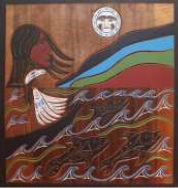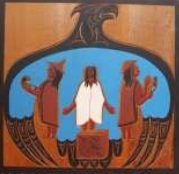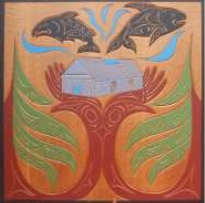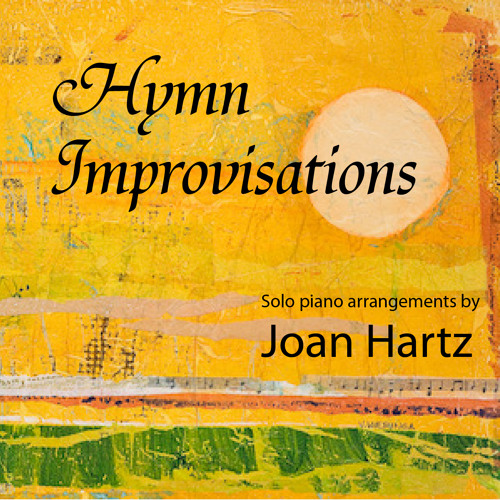This is the seventh and final post in a series on Christian art of the Pacific Northwest Coast. Read part 1 here.
St. Andrew’s Cathedral in Victoria, British Columbia, is home to a hand-carved yellow cedar altar by Tsartlip artist Charles W. Elliott. The base consists of two bentwood boxes with a design carved onto each of the eight faces. These boxes rotate throughout the liturgical year so that the front-facing images correspond to the current seasons in the church calendar.

Charles W. Elliott, Eucharist and Spiritual Nourishment, 1987. Yellow cedar altar box carvings, St. Andrew’s Cathedral, Victoria, British Columbia. Photo: Trish Simpson-Boulsbee.
The bentwood box is a traditional Northwest Coast art object, typically used to store food or clothing. They are made out of a single plank of wood that is kerfed, steamed, and bent into shape—hence the name. (The bottom and lid, however, are separate pieces. To read a more detailed description of the creation process, see pages 89-92 of Hilary Stewart’s Cedar: Tree of Life to the Northwest Coast Indians.) St. Andrew’s does not store anything inside the boxes, choosing to use them not for utilitarian purposes, but for the purpose of inspiring spiritual meditation.
St. Andrew’s commissioned this carved altar in 1987 to commemorate the twenty-fifth anniversary of Remi De Roo’s ordination as Bishop of Victoria in 1962. Having served in that position until retirement in 1999, De Roo is Canada’s longest-serving Catholic bishop. He is known for being a proponent of social action and liberation theology.
The artist, Charles Elliott, is self-taught and works in the mediums of drawing, painting, woodcarving, printmaking, and clothing design. He has dedicated his life to reviving the Coast Salish art tradition, which he says is the least known of all the Northwest Coast styles. To this end, he mentors young artists and teaches in classroom and organizational settings. He lives on the Saanich Peninsula on southern Vancouver Island.

Charles W. Elliot at the Second International Marine Conservation Congress in Victoria, British Columbia, in May 2011. He designed the congress’s logo, depicting an orca, human, and raven in conversation with one another (top left). Photo © kipevansphotography.com.
To see a sampling of works by Elliott, visit the Victoria International Airport website. To see details of the totem pole he carved for the University of Victoria in 1990, see the photography blog Burnt Embers.
The following thumbnails are courtesy of Saint Andrew’s Cathedral, and the descriptions are based loosely on those they supplied me with in this PDF, presumably written by the artist.
ADVENT / CHRISTMAS / EPIPHANY
 The Advent panel is called Raven-Woman: Mary Pregnant with the Word. Rather than depicting the Journey to Bethlehem, this here depicts the Journey to Vancouver Island. Mary rides not on a donkey but in a canoe, propelled forward by the wind, or Holy Spirit: he breathed God’s seed into her womb, and now he guides her through to full term, after which the gift she carries will be birthed into the world. The canoe emphasizes the concept of Mary as vessel, her womb being a container for the unborn Christ child. Her physical journey by sea from geographical points A to B in this image echoes the roiling emotional and spiritual journey she likely underwent during her pregnancy. This panel emphasizes the characteristic Advent ideas of waiting, expectation, hope. Along with Mary, we wait for Christ’s coming.
The Advent panel is called Raven-Woman: Mary Pregnant with the Word. Rather than depicting the Journey to Bethlehem, this here depicts the Journey to Vancouver Island. Mary rides not on a donkey but in a canoe, propelled forward by the wind, or Holy Spirit: he breathed God’s seed into her womb, and now he guides her through to full term, after which the gift she carries will be birthed into the world. The canoe emphasizes the concept of Mary as vessel, her womb being a container for the unborn Christ child. Her physical journey by sea from geographical points A to B in this image echoes the roiling emotional and spiritual journey she likely underwent during her pregnancy. This panel emphasizes the characteristic Advent ideas of waiting, expectation, hope. Along with Mary, we wait for Christ’s coming.
 The Incarnation shows Christ-as-Thunderbird embracing all of creation—flower, bird, fish, mammal, and man—with his leaflike wings. The sun shines on from the left, while the wind blows from the right. Everyone and everything celebrates the arrival of Christ, whose imprint they bear.
The Incarnation shows Christ-as-Thunderbird embracing all of creation—flower, bird, fish, mammal, and man—with his leaflike wings. The sun shines on from the left, while the wind blows from the right. Everyone and everything celebrates the arrival of Christ, whose imprint they bear.
 Epiphany depicts the Three Wise Men at a potlatch ceremony. The central figure, the chief, stands behind a bentwood box, where the gifts are stored. The figure on the left holds a bowl, and the figure on the right holds a rattle—both objects associated with potlatching, the former used for feasting, and the latter used to communicate with the spirit world. As in The Incarnation, the figures are embraced by Thunderbird, suggesting that God is the real source of the gifts.
Epiphany depicts the Three Wise Men at a potlatch ceremony. The central figure, the chief, stands behind a bentwood box, where the gifts are stored. The figure on the left holds a bowl, and the figure on the right holds a rattle—both objects associated with potlatching, the former used for feasting, and the latter used to communicate with the spirit world. As in The Incarnation, the figures are embraced by Thunderbird, suggesting that God is the real source of the gifts.
ORDINARY TIME
 The Ordinary Time panel, which designates those periods during the year in which no other feast days fall, is called Spiritual Nourishment. In it Christ presents a basket of fish with open hands and closed eyes, symbolizing his giving, prayerful spirit. The gift he gives is himself. (For contextual relevance, fish is here substituted for the Eucharistic bread.) Besides the Lord’s Supper, the image also calls to mind the story of the five loaves and two fishes; here the fish have already started multiplying, a sign of God’s miraculous provision. The canoe at the bottom of the panel symbolizes the church, the vessel that is called upon to carry Christ’s gifts to others, to bring spiritual nourishment to the world through word and deed.
The Ordinary Time panel, which designates those periods during the year in which no other feast days fall, is called Spiritual Nourishment. In it Christ presents a basket of fish with open hands and closed eyes, symbolizing his giving, prayerful spirit. The gift he gives is himself. (For contextual relevance, fish is here substituted for the Eucharistic bread.) Besides the Lord’s Supper, the image also calls to mind the story of the five loaves and two fishes; here the fish have already started multiplying, a sign of God’s miraculous provision. The canoe at the bottom of the panel symbolizes the church, the vessel that is called upon to carry Christ’s gifts to others, to bring spiritual nourishment to the world through word and deed.
 In a reversal of roles, Eucharist (lit. “thanksgiving”) depicts Christ’s people presenting a gift to him. Christ founded a church, and now his church offers itself back in praise. The flames emitting from the roof represent the Holy Spirit, for having received the Spirit as a gift from Christ, the people now use the Spirit’s gifts to serve Christ and build up his body. As in Spiritual Nourishment, the fish represent the Eucharistic feast that Christ’s people partake in regularly. In this meal, we consume Christ, and being therewith filled up with grace, we share that grace with others. The trees represent the people’s stewardship of the planet and all its natural resources.
In a reversal of roles, Eucharist (lit. “thanksgiving”) depicts Christ’s people presenting a gift to him. Christ founded a church, and now his church offers itself back in praise. The flames emitting from the roof represent the Holy Spirit, for having received the Spirit as a gift from Christ, the people now use the Spirit’s gifts to serve Christ and build up his body. As in Spiritual Nourishment, the fish represent the Eucharistic feast that Christ’s people partake in regularly. In this meal, we consume Christ, and being therewith filled up with grace, we share that grace with others. The trees represent the people’s stewardship of the planet and all its natural resources.
LENT / EASTER
 In Jonah in the Belly of a Whale, the whale is both tomb and womb—while Christ lies dead in its belly, he is actually preparing to be born again into eternal, resurrected life. He breathes through the whale’s blowhole, softly at first—with the explosive burst soon to come. This is a picture of transition.
In Jonah in the Belly of a Whale, the whale is both tomb and womb—while Christ lies dead in its belly, he is actually preparing to be born again into eternal, resurrected life. He breathes through the whale’s blowhole, softly at first—with the explosive burst soon to come. This is a picture of transition.
 The Risen Christ shows Christ rising from his tomb. The sun’s rays (God the Father) beckon him to life, as does the eagle, representing the Holy Spirit.
The Risen Christ shows Christ rising from his tomb. The sun’s rays (God the Father) beckon him to life, as does the eagle, representing the Holy Spirit.
PENTECOST
In Pentecost, the Holy Spirit is embodied in three  different forms: wind, fire, and eagle. Like the wind, the Spirit gives direction, and his presence is seen not directly, but through the effects he has on those in his path. Like fire, he ignites our hearts and powers us. Like the eagle in Northwest Coast culture (and the dove in Western culture), he is the harbinger of peace.
different forms: wind, fire, and eagle. Like the wind, the Spirit gives direction, and his presence is seen not directly, but through the effects he has on those in his path. Like fire, he ignites our hearts and powers us. Like the eagle in Northwest Coast culture (and the dove in Western culture), he is the harbinger of peace.
If you have any higher-resolution images of these panels that you’d be willing to provide me with to replace the ones currently on this page, please let me know.


Pingback: One with Christ: Prints by Roy Henry Vickers | The Jesus Question